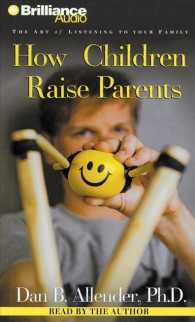Full Description
In a polarized world, educators face the challenge of addressing controversial issues in the classroom. This book provides an in-depth exploration of the ethical, philosophical, and practical considerations involved in discussing sensitive topics. Drawing on case studies from Israel and Western democracies, the author offers actionable strategies for fostering critical thinking and civic engagement in students. It addresses the complexities of balancing diverse perspectives, navigating potential conflicts, and promoting informed discussions. Essential for educators, parents, and policymakers, this book serves as a vital resource for those seeking to prepare students for active participation in democratic societies across the globe.
Contents
Introduction
1 Book Structure
PART 1: Theoretical Examination of the Concept and Presentation of Its Objectives
Introduction to Part 1
1 What Exactly Are "Controversial Public Issues?"
1 Controversial Public Issues: Defining and Clarifying the Concept
2 First Delineation: "Excluded from the Circle"
3 Second Delineation: "The Circle of Reason"
4 The Language of Controversy
5 Matters of Emotion
6 A Critical Examination of the Epistemic Criterion
7 Third Delineation: "Circle of Public Examination"
8 Summary
2 The Aim of Teaching Controversial Public Issues in the Classroom
1 Central Models of Democracy
2 In Praise of Listening to the Other Voice and Making It Heard: From Past to Present
3 The Connection between Teaching Controversial Public Issues and Liberal-Democratic Ideology
4 Arguments Supporting the Teaching of Controversial Public Issues in Schools
5 Voices Critiquing the Necessity of Discussion on Controversies and Its Objectives
6 Summary
3 Political Education, Ideological Education, and Indoctrination
1 Conceptual Examination: What Does "Political" Really Mean?
2 Second Conceptual Examination: What Is "Political Education?"
3 Liberal-Democratic Political Education
4 Critical and Agonistic Political Education
5 Conceptual Examination: Ideological Education and Indoctrination
6 Indoctrination
7 Demonstration of Ideological Indoctrination
8 Summary
4 On the Importance of Context in Engaging with Publicly Controversial Issues
1 The Context of Time and Place
2 The Context of Classroom Dynamics
3 The Ideological-Political Context in a Multisectoral Society
4 The Classroom Context: The Social Group
5 The Personal Context: Personal Characteristics of the Students
6 Cognitive Differences
7 Inclusion of Students with Special Needs
8 Gender of the Students in the Class
9 Emotional and Social Differences
10 The Context of Knowledge Domain
11 Contextual and Non-Contextual Knowledge
12 The School Context
13 Summary
5 The Importance of a Teacher's Guiding Educational Ideology
1 The Necessity of Ideological Choice in Education
2 On Meta-Ideologies in Education
3 The Meta-Ideology Centered on Society ("Ideology of Socialization")
4 The Educational Ideology Centered on Culture (Acculturation)
5 The Educational Ideology Focused on the Individual (Individuation)
6 Ideological Turn: Contemplative Education
7 A Mix of Ideologies
8 The Intersection of Engaging with Controversial Public Issues and Education Driven by an Agenda
9 Critical Pedagogy
10 Summary
6 Possible Methods for Teaching and Learning Controversial Public Issues
1 Open Discussion vs. Closed Discussion
2 The Teacher's Role in Managing Open Discussions
3 Types of Discussions on Controversial Public Issues
4 Initiating and Planning Discussions on Publicly Controversial Issues
5 The Debate on Teachers' Disclosure of Personal Views in Publicly Controversial Issues
6 How Can Teachers Assess the Way They Taught Controversial Public Issues?
7 Expression of Interest in Public Controversial Topics
PART 2: Examples of Controversial Issues, Presenting Problems, and Proposing Solutions
Introduction to Part 2
7 Critical Race Theory (CRT) as a Controversial Issue
1 Introduction
2 Part One: On Critical Race Theory
3 Academic Roots of CRT
4 Criticisms of Critical Race Theory (CRT)
5 The Political Reaction to Critical Race Theory
6 The Relevance of Critical Race Theory in Non-American Contexts
7 Part Two: The Question of Addressing Critical Race Theory in Schools
8 The Options Available to the Teacher
9 The First Option: Classroom Political Discussion
10 The Second Option: Apolitical Discussion
11 The Third Option: A Moral Discussion
12 The Fourth Option: An Ideological Discussion
13 Summary
8 On the Challenges of Teaching Controversial Topics in Our Time
1 Introduction
2 The Current Challenges in Teaching Controversial Public Issues
3 Sub-Argument 1: Distinguishing between Teaching Argumentation Skills and Addressing Controversial Public Issues
4 Sub-Argument 2: Discussions on Controversial Public Issues Do Not Necessarily Prepare Students for Real Civic Life
5 Sub-Argument 3: Social Reality Is Not Dialogical and Is Permeated by the Silencing of Opposing Views
6 Sub-Argument 4: Teachers and Schools Driven by Ideology Will Find It Difficult to Conduct Open and Dialogical Discussions on Controversial Public Issues
7 Sub-Argument 5: Public Controversial Issues Are Ideologically Context-Dependent
8 Sub-Argument 6: Many Students Lack the Knowledge and Skills Required for a Serious and Productive Discussion on Controversial Public Issues
9 Sub-Argument 7: Individual Differences among Students Hinder Open Participation in Classroom Discussions
10 Sub-Argument 8: Many Teachers Lack the Political Knowledge, General World Knowledge, and Intellectual Capacity Necessary to Conduct Classroom Discussions on Controversial Public Issues
11 Sub-Argument 9: When Some Parents and Students Oppose Discussions on Controversial Public Issues, such Discussions May Be Avoided
12 Summary
9 Paving the Way: Guidelines for Teaching Controversial Public Issues in the Present Era
1 Steps Required for Addressing Controversial Public Issues
2 Creating a Suitable Classroom Atmosphere
3 Preparing for Dialogue Management
4 Promoting Literacy
5 Political Literacy
6 Disciplinary Literacy
7 Media Literacy
8 Multicultural Literacy
9 Logical Literacy
10 Determining the Content and Topics for Discussion
11 Defining Objectives
12 Context and Ideology
13 Selection of Topics
14 Additional Comments and Insights
15 Concluding Remarks
References
Index







